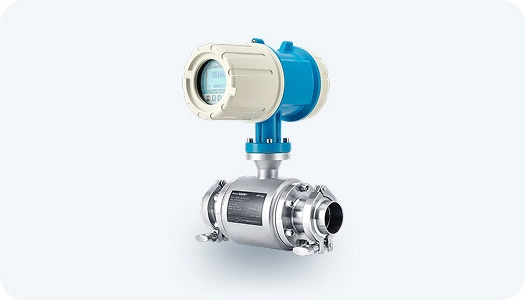-
Date:2025-10-30
-
Page View:28
A sewage flow meter is considered one of the more challenging instruments to use and select. The difficulty lies not only in the highly corrosive and complex nature of the measured medium but also in the variety of meter types available—such as electromagnetic, ultrasonic, vortex, and rotor sewage flow meters. Given the complexity of options, what factors should be considered when selecting the right one?
Understand the Sewage Characteristics
Before purchasing a flow meter, it’s essential to understand what type of wastewater needs to be measured. Common sources include power plants, steel mills, chemical plants, paper mills, and domestic wastewater. Each type of sewage is best suited to a different flow meter.
For example, paper mills often require flow meters designed specifically for pulp and wastewater measurement. It’s also important to know the composition of the sewage in order to choose the proper liner and electrode materials.
Consider factors such as the degree of corrosion, and the amount of solids or impurities in the fluid. If the wastewater composition is unclear, you can assess the corrosiveness by examining the pipe material and then select a corrosion-resistant flow meter accordingly.
Understand the Installation Conditions
The installation environment also plays a crucial role in selecting a sewage flow meter. Factors such as the length of straight pipe runs, site interference, and environmental conditions should be carefully evaluated.
Different sewage flow meters have different installation requirements. For instance, electromagnetic flow meters require a certain length of straight pipe before and after the sensor, a stable environment free from strong electromagnetic interference, and controlled temperature and humidity levels at the installation site.
Types of Sewage Flow Meters
1. Electromagnetic Flow Meter
Electromagnetic flow meters are widely used in wastewater measurement and are specifically designed for conductive liquids. They offer several advantages, including no risk of clogging, low pressure loss, high accuracy and reliability, excellent linearity, and a wide measurement range. Additionally, their performance is not affected by changes in fluid viscosity, temperature, or pressure.
In most applications—such as domestic sewage, industrial wastewater, and reclaimed water—as long as the fluid is conductive, the electromagnetic flow meter is typically the first choice.
2. Ultrasonic Flow Meter
Ultrasonic flow meters are especially suitable for large-diameter pipelines and are a cost-effective solution. However, they require a relatively clean medium—excessive air bubbles or solid particles can interfere with sound wave transmission, causing signal attenuation or unstable readings. Furthermore, scaling or lining conditions inside the pipe can also affect measurement accuracy.
3. Open Channel Flow Meter
An open channel flow meter does not measure flow directly; instead, it determines the liquid level in a weir or flume and then calculates the flow rate based on geometric relationships. This type of flow meter is designed for partially filled channels and streams, making it ideal for inlet, outlet, and open drainage channels in wastewater treatment plants.
4. Differential Pressure Flow Meter
Differential pressure flow meters are known for their robust structure and mature technology. However, they also have limitations—such as prone to clogging, high pressure loss, higher energy consumption, and measurement accuracy affected by fluid density variations. Therefore, careful consideration of actual operating conditions is essential when selecting this type of flow meter.

Ultrasonic Flow Transmitter

Flow Meters for Sewage
How to Choose a Sewage Flow Meter
Understand the characteristics of the sewage.
The nature of the wastewater is a key factor. If the sewage contains a large amount of solid particles, fibers, or other impurities, it’s important to choose a flow meter with good wear resistance and anti-clogging performance — such as an electromagnetic flow meter or ultrasonic flow meter.
Electromagnetic flow meters are ideal for measuring conductive liquids, and their readings are not affected by impurities. However, they are not suitable for non-conductive liquids.
Ultrasonic flow meters, on the other hand, can measure a wide range of liquids, including those containing impurities, but they require a clear measurement path without obstacles for accurate operation.
Consider the flow range.
Select a flow meter with a measurement range that matches the actual sewage flow. If the flow rate exceeds the instrument’s range, it can lead to inaccurate measurements or even damage to the flow meter.
Evaluate the installation conditions.
If installation space is limited, choose a compact-sized flow meter. For harsh environments—such as high temperature, high pressure, or highly corrosive conditions—select a model with an appropriate protection rating (e.g., IP68) and corrosion resistance.
Check the performance indicators.
Important parameters include accuracy, stability, and response time.
High-accuracy meters provide more precise data but are typically more expensive.
Meters with good stability maintain consistent accuracy over long-term operation.
Fast response meters can quickly reflect changes in flow rate.
Consider maintenance cost and ease of use.
Some flow meters require regular maintenance and calibration, leading to higher operating costs. Others are designed for simple operation and low maintenance, offering more convenience in daily use.
In summary, selecting the right sewage flow meter requires a comprehensive evaluation of the sewage characteristics, flow range, installation environment, performance indicators, maintenance cost, and user convenience. The final choice should be based on your specific application and operating conditions.










